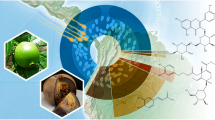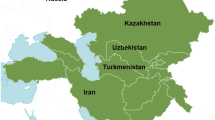Abstract
Elaeocarpus floribundus Blume belongs to the Elaeocarpaceae family which is widely distributed across warm regions like Madagascar, Mauritius, India, Southeast Asia, and Hawaii. In recent years, there has been a drive to unveil unique pharmacological activities and new bioactive compounds that could be prophylactic in nature. This food plant has been used for traditional purposes to treat/manage diseases like diabetes, hypertension, dysentery, and rheumatism. Though the fruit is well used by men as pickles and chutney, there is lack of an integrated research and critical appraisal of the existing literature on the use of Elaeocarpus floribundus. One element to consider that has attracted researchers to this plant is the wide array of pharmacological potential that the Elaeocarpaceae family has been highlighted for. The Eleocarpaceae is well known for the presence of indolizidine alkaloid and inhibitory properties against glucosidases. Another facet of interest is potentially of multitude cucurbitacin in the Elaeocarpaceae family which has documented to possess a diversity of health benefits. Various compounds have been isolated from different species of the genus Elaeocarpus such as the cucurbitacins D and F, 1,2,3,4,6-penta-O-galloyl-b-d-glucose, and rudrakine that has been associated with therapeutic effects on many diseases. The aim is to bring to light this highly undocumented plant and existing pharmacological activities that have been expressed by parts of the plant. Current findings on E. floribundus have shown a plethora of phytochemicals especially phenolic compounds. It has also been reported to exhibit antibacterial, inhibitory action against glucosidases and also interesting inhibitory effect against HeLa cancer cell as well as strong cytotoxic activities on the proliferation of four human cancer cells. Thus, this plant has realm of possibility to be used in treatment of diabetes, cancer, and infectious diseases. This amalgamation of ethnobotanical and pharmacological data would enable a well-rounded understanding of Elaeocarpus floribundus and its wider potential. The highlights so far have been attractive and promise potential outlets with different pharmacological properties.
Access this chapter
Tax calculation will be finalised at checkout
Purchases are for personal use only
Similar content being viewed by others
References
Abbasi A, Khan M, Ahmad M, Zafar M, Jahan S, Sultana S (2010) Ethnopharmacological application of medicinal plants to cure skin diseases and in folk cosmetics among the tribal communities of North-West Frontier Province, Pakistan. J Ethnopharmacol 128(2):322–335
Burkill IH, Birtwistle W, Foxworthy FW, Scrivenor JB, Watson JG (1966) A dictionary of the economic products of the Malay peninsula. Kuala Lumpur, Malaysia, Governments of Malaysia and Singapore, Ministry of Agriculture and Cooperative
Butler M (2004) The role of natural product chemistry in drug discovery. J Nat Prod 67(12):2141–2153
Choi BM, Kim HJ, Oh GS, Pae HO, Oh H, Jeong S (2002) 1,2,3,4,6- Penta-O-galloyl-beta-D-glucose protects rat neuronal cells (Neuro 2A) from hydrogen peroxide-mediated cell death via the induction of heme oxygenase-1. Neurosci Lett 328:185–189
Coode MJE (1984) Elaeocarpus in Australia and New Zealand. Kew Bull 39:509–586
Crayn D, Rossetto M, Maynard D. 2006. "Molecular phylogeny and dating reveals an Oligo-Miocene radiation of dry-adapted shrubs (former Tremandraceae) from rainforest tree progenitors (Elaeocarpaceae) inAustralia". American Journal of Botany 93(9):1328–1342
Dadhich A, Rishi A, Sharma G, Chandra S (2011) Phytochemicals of Elaeocarpus with their therapeutic value: a review. Int J Pharm Bio Sci 4(3):591–598
Das N (2014) The effect of seed sources variation and presowing treatments on the seed germination of Acacia catechu and Elaeocarpus floribundus species in Bangladesh. Int J For Res 2014:1–2
Fang X, Phoebe CH, Pezzuto JM, Fong HHS, Farnsworth NR, Yellin B, Hecht SM (1984) Plant anticancer agents, XXXIV. Cucurbitacins from Elaeocarpus dolichostylus. J Nat Prod 47(6):988–993
Gurib-Fakim A (2006) Medicinal plants: traditions of yesterday and drugs of tomorrow. Mol Asp Med 27(1):1–93
Gurib-Fakim A, Guého J, Bissoondoyal MD (1996) Plantes médicinales de Maurice, tome 2. Editions de l’Océan Indien, Rose-Hill, Mauritius, p 532
Ito A (2002) Ellagic acid derivatives and cytotoxic cucurbitacins from Elaeocarpus mastersii. Phytochemistry 61(2):171–174
Kang DG, Moon MK, Choi DH, Lee JK, Kwon TO, Lee HS (2005) Vasodilatory and anti-inflammatory effects of the 1,2,3,4,6-penta-O-galloylbeta- D-glucose (PGG) via a nitric oxide-cGMP pathway. Eur J Pharmacol 524:111–119
Katavic P, Venables D, Forster P, Guyme G, Carroll A (2006) Grandisines C−G, indolizidine alkaloids from the Australian rainforest tree Elaeocarpus grandis. J Nat Prod 69(9):1295–1299
Khalil MMH, Ismail EH, Baghdady KZ, Mohamed D (2013) Green synthesis of silver nanoparticles using olive leaf extract and its antibacterial activity. Arab J Chem:1–23
Kinghorn AD, Farnsworth NR, Soejarto DD, Cordell GA, Pezzuto JM, Udeani GO, Wani MC, Wall ME, Navarro HA, Kramer RA, Menendez AT, Fairchild CR, Lane KE, Forenza S, Vyas DM, Lam KS, Shu YZ (1999) Novel strategies or the discovery of plant-derived anticancer agents. Pure Appl Chem 71:1611–1618
Lee S, Lee I, Mar W (2003) Inhibition of inducible nitric oxide synthase and cyclooxygenase-2 activity by 1,2,3,4,6-Penta-O-galloyl-β-D-glucose in murine macrophage cells. Arch Pharm Res 26(10):832–839
Nandy B, Hardainiyan S, Kumar K (2015a) Elaeocarpus Ganitrus (Rudraksha): a reservoir plant with their pharmacological effects. Int J Pharm Sci Rev Res 34(1):55–64
Nandy B, Hardainiyan S, Saxena R (2015b) Phytochemical investigation of fruit extract of Elaeocarpus ganitrus. Int J Pharm Pharm Sci 7(6):415–418
Oh GS, Pae HO, Oh H, Hong SG, Kim IK, Chai KY (2001) In vitro anti-proliferative effect of 1,2,3,4,6-penta-O-galloyl-beta-D-glucose on human hepatocellular carcinoma cell line, SK-HEP-1 cells. Cancer Lett 174:17–24
Pae HO, Oh GS, Jeong SO, Jeong GS, Lee BS, Choi BM (2006) 1,2,3,4,6-penta-O-galloyl-beta-D-glucose up-regulates heme oxygenase-1expression by stimulating Nrf2 nuclear translocation in an extracellular signal-regulated kinase-dependent manner in HepG2 cells. World J Gastroenterol 12:214–221
Piao M, Kang K, Zhang R, Ko D, Wang Z, Lee K, Chang W, Chae S, Jee Y, Shin T, Park J, Lee N, Hyun J (2009) Antioxidant properties of 1,2,3,4,6-penta-O-galloyl-β-d-glucose from Elaeocarpus sylvestris var. ellipticus. Food Chem 115(2):412–418
Pullaiah T (2006) Encyclopedia of world medicinal plants. Regency Publication, New Delhi, pp 852–853
Qureshi R, Ghazanfar S, Obied H, Vasileva V, Tariq M (2016) Ethnobotany: a living science for alleviating human suffering. Evidence-Based Complementary and Alternative Medicine 2016:9641692 3 pages
Ray AB, Dutta SC, Dasgupta S (1976) Flavanoids of Elaeocarpus lanceofolius. Phytochemistry 15:1797–1798
Rodriguez N, Vasquez Y, Hussein A, Coley P, Solis P, Gupta M (2003) Cytotoxic Cucurbitacin constituents from Sloanea zuliaensis. J Nat Prod 66(11):1515–1516
Sakat S, Bodhankar S, Juvekar M, Wankhede S, Mali V, Juvekar A (2009) Study of antihypertensive activity of Elaeocarpus ganitrus water extract in renal artery-occluded hypertensive rats. Planta Med 74:9
Shah G, Singh P, Mann A, Shri R (2011) Scientific basis for the chemical constituent and therapeutic use of Elaeocarpus species: a review. Int J Institutional Pharm Life Sci 1(1):267–278
Sircar B, Mandal S (2017) Screening of Elaeocarpus floribundus fruit extracts for bioactive phytocomponents and antibacterial activity against food-borne bacteria. Int J Res Med Sci 5(8):3665
Sircar B, Mandal M, Mandal S (2017a) Indian olive, Elaeocarpus floribundus fruits in combating MRSA infection. J Coastal Life Med 5:501–503
Sircar B, Mandal M, Mondal M, Mandal S (2017b) High performance liquid chromatography analysis and anti-methicillin resistant Staphylococcus aureus activity of olive fruit ethanolic extract. Int Res J Pharm 8(7):126–130
Sukari M, Utami R, Khalid N, Rahmani M, Abdul A, Dachriyanus (2013) Phenolic contents, antioxidant and cytotoxic activities of Elaeocarpus floribundus Blume. Pak J Pharm Sci 26(2):245
Wiart C (2006) Medicinal plants of Asia and the Pacific. CRC/Taylor & Francis, Boca Raton
Zaman S (2016) Exploring the antibacterial and antioxidant activities of Elaeocarpus floribundus leaves. Indo Am J Pharm Sci 3(2):92–97
Author information
Authors and Affiliations
Corresponding author
Editor information
Editors and Affiliations
Rights and permissions
Copyright information
© 2018 Springer International Publishing AG, part of Springer Nature
About this chapter
Cite this chapter
Mahomoodally, M.F., Sookhy, V. (2018). Ethnobotany and Pharmacological Uses of Elaeocarpus floribundus Blume (Elaeocarpaceae). In: Ozturk, M., Hakeem, K. (eds) Plant and Human Health, Volume 1. Springer, Cham. https://doi.org/10.1007/978-3-319-93997-1_4
Download citation
DOI: https://doi.org/10.1007/978-3-319-93997-1_4
Published:
Publisher Name: Springer, Cham
Print ISBN: 978-3-319-93996-4
Online ISBN: 978-3-319-93997-1
eBook Packages: Biomedical and Life SciencesBiomedical and Life Sciences (R0)




